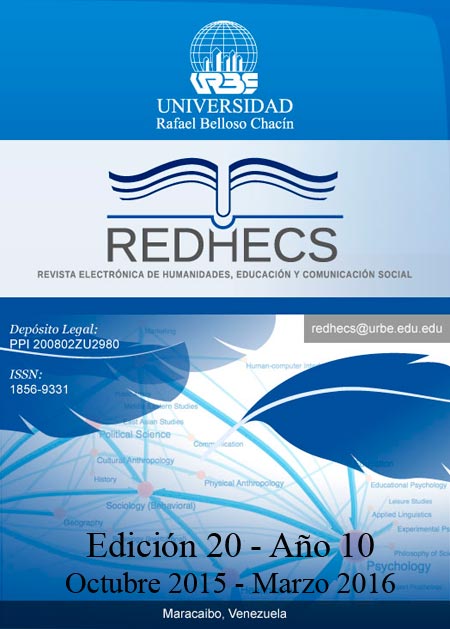El papel de la interferencia en los errores de los aprendices de una segunda lengua
Resumen
Este trabajo pretende desarrollar una estructura teórica para determinar si los errores que los alumnos cometen en el aprendizaje de una segunda lengua, se deben a interferencia de la lengua materna o L1. Se hace una revisión histórica de los conceptos de interferencia, y se presentan los resultados obtenidos en algunos proyectos de investigación llevados a cabo por diferentes autores, así como algunas observaciones derivadas de expresiones escritas y orales de los estudiantes de la Universidad Privada Dr. Rafael Belloso Chacín. Luego, se examinaron diferentes enfoques relacionados con los conceptos de error y equivocación, como posible consecuencia de la interferencia de la lengua nativa y algunas estrategias en la corrección de errores. Los resultados de este artículo sugieren que la interferencia se considera como transferencia y como un factor positivo y útil en el proceso de competencia comunicativa.
Descargas
Citas
Arrufat, Y. (2010). How to deal with language transfer in the English classroom. Documento en línea. Disponible en: www.eduinnova.es/mar2010/how_to_deal.pdf. Consulta: 06/06/2011.
August, D.; Calderón, M. y Carlo, M. (2001). The transfer of skills from Spanish to English: a study of young learners. Estados Unidos. Center for Applied Linguistics.
Bley–Vroman, R. (1990). The logical problem of foreign language learning. Linguistic Analysis. Volumen 20, número 1-2. (Pp. 3-47).
Bordag, D. (1996). Cross-linguistic influence in production of grammatical gender: a psycholinguistic study. 13 Conferencia Anual de la Asociación Europea de Segundos Lenguajes (EUROSLA). Septiembre, Edinburgo.
Brown, H. (2001). Teaching by principles: an interactive approach to language pedagogy. Estados Unidos. Longman,Inc.
Brown. H. (2000). Principles of language learning and teaching. Estados Unidos. Longman, Inc.
Chomsky, N. (1957). Syntactic Structures. Estados Unidos. Massachusetts Institute of Technology.
Chomsky, N. (1965). Aspects of the theory of syntax. Estados Unidos. Massachusetts Institute of Technology.
Corder, P. (1967). The significance of learner errors. International Review of Applied Linguistics (IRAL). Volumen 5, edición 2-3. (Pp. 161-170).
Dulay, H. and Burt, M. (1975). Creative construction in second language learning and teaching. En Burt, M. y Dulay, H. (Editores).
New directions in second language learning, teaching and bilingual education: selected papers from the ninth annual Teachers of
English to Speakers of Other Languages (TESOL) Convention. Estados Unidos. University Microfilm.
Eckman, F. e Iverson, G. (1994). Pronunciation difficulties in ESL: coda consonants in English interlanguage. En Yavas, M. (Editor).
First and Second Language Phonology. Estados Unidos. Singular Publishing Group.
Ellis. R. (1994). The study of second language acquisition. Reino Unido. Oxford University Press.
Ellis. R. (1997). SLA Research and Language Teaching. Reino Unido. Oxford University Press.
Erdogan, V. (2005). Contribution of error analysis to foreign language teaching. Mersin University Journal of the Faculty of Education. Turquía. Volumen 1, edición 2. (Pp. 261-270).
Escutia. M. (2.002). First language effect on Spanish learners. Production of English Embedded Interrogative Clauses. España.
Centro de Estudios Superiores Felipe II de la Universidad Complutense de Madrid.
Krashen, S y Terrel, T. (1982). The natural approach: language acquisition in the classroom. Reino Unido. Prentice Hall, Europe.
Krashen, S. (2004). Applying the comprehension hypothesis. Some Suggestions. Taiwan. English Teachers Association of the Republic of China.
Krashen. S. (1978). The monitor model for second language acquisition. En Gingras, R. (Editor). Second language acquisition and foreign language teaching. Estados Unidos. Center for Applied Linguistics.
Lado, R. (1957). Contrastive analysis: an overview. En Lado, R. Linguistics across cultures: applied linguistics for language teachers. Estados Unidos. University of Michigan Press.
Nunan, D. (1999). Second language teaching and learning. Estados Unidos. Heinle and Heinle.
Poma, S. y Toledo, E. (2009). Native language interference in learning english as a foreign language: an analysis of written material produced by Spanish speaking students in senior High School classes. Tesis de grado. Licenciatura en Ciencias de la Educación mención inglés. Universidad Técnica Particular de Loja. España.
Selinker, L. (1972). Interlanguage. Reino Unido. Longman.
Selinker, L. (1992). Rediscovering interlanguage. Applied Linguistics in Language Study. Reino Unido. Longman.
Skiba, R. (2000). Zero Tolerance, zero evidence. An analysis of school disciplinary practice. Policy Research Report. Número SRS2. (Pp. 1-20).
Spada. N. (1997). Form focused instruction and second language acquisition. A review of classroom and laboratory research. Language Teaching. Edición 30. (Pp. 73-87).
Tarone, E. (1982). Systematicity and attention in interlanguage. Language Learning. Edición 32. (Pp. 69-84).
Velasco, G. y Mármol, M. (2009). Native language interference in learning English as a foreign language: an analysis of written material produced by Spanish Speaking Students in Senior High School Classes. Tesis de grado. Licenciatura en Ciencias de la Educación mención inglés. Centro Universitario Quito, Ecuador.
Weinreich, U. (1953). Languages in contact. Findings and problems. Estados Unidos. Mouton Publishers.


